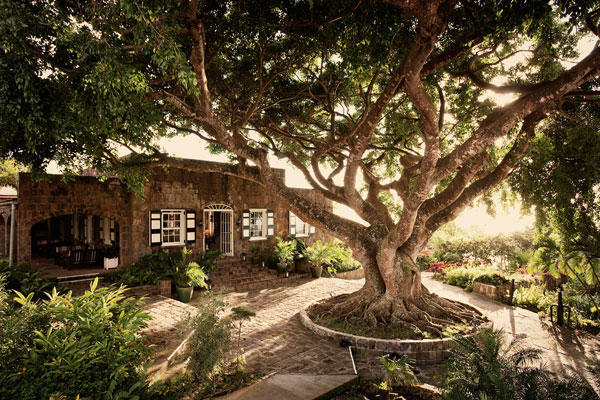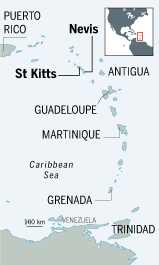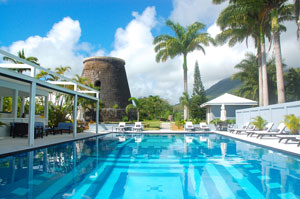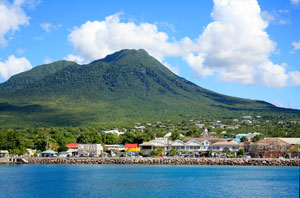The Caribbean island of Nevis has rich history and charming hotels

Simply sign up to the Life & Arts myFT Digest -- delivered directly to your inbox.
It’s easy to forget, living in northern Europe as I do, that rain needn’t always fall in persistent, cold drizzle. It can also be violent and swift. I was floating in the smooth waters of the Caribbean when a sudden darkness passed overhead and the water around me changed colour: gunmetal, sludge-green, black. Seconds later, the glassy plain was studded with white polka dots from the heavens. The air became thick, a translucent veil that briefly hid the neighbouring island. I stayed where I was, watching lightning bolts jab at distant promontories.
That wasn’t the only big rainstorm I experienced. Another day, I was mesmerised by the sheer force of raindrops that transformed the surface of the hotel pool so that it was impossible to see the bold geometric pattern of the tiles beneath. And it was a rainstorm that delayed my arrival, extending further the already lengthy journey from London to St Kitts via Antigua, then by boat across the channel to Nevis (pronounced “knee-vis”).
But I wasn’t complaining. Remoteness has preserved Nevis as an exclusive, unspoilt haven, little changed since Diana, Princess of Wales, came here with her sons in 1992 to escape the media. And the rain? Well, that passes as quickly as it arrives. Not long after that rainstorm at sea, for example, I was back on the hotel’s private beach, playing a game of cricket with other residents and staff. The best bowler was a waitress whose deliveries at breakfast and dinner were, mercifully, much gentler.
I had come to the island on the 30th anniversary of its independence from Britain. The Federation of St Kitts and Nevis is the smallest sovereign state in the Americas, with a combined total of 100 sq miles and some 50,000 inhabitants. Today, Nevis is home to more offshore companies than human beings. Citizenship is available to buy and has been acquired by large numbers of people who can afford to pay for the convenience of a St Kitts and Nevis passport; residency is not a requirement.

Nevis, the smaller of the two islands, has a rich history largely because of its fertile volcanic soil: the circular island consists almost entirely of a single mountain, Nevis Peak (985m), which is often shrouded in cloud. Columbus was here and so was Captain John Smith; and a thriving sugar trade developed off the back of slave labour and the secrets of crystallisation brought by Jews expelled from South America. As you drive round the island, you can’t miss the sugar mills in various states of ruin.
France seized the island in the late 18th century, capturing slaves for sale in Martinique. (The French are also blamed for introducing African monkeys to control the muskrats; today, the monkeys are a pest in their own right.) After Britain took Nevis back, a young Horatio Nelson was dispatched to guard it. While here, he met a plantation owner’s niece, the 26-year-old widow Fanny Nisbet, and married her under the vast cottonwood tree in the grounds of what has become my hotel.

One of six former plantations on the island, the Montpelier is part of the Relais & Châteaux group. When Princess Diana stayed here, the hotel had British owners, but in 2002 it was taken over by an American family. Food combines the native cuisine of the French chef, Benjamin Voisin, with local ingredients in ways that made me laugh with pleasure: I’m thinking in particular of a beet jelly with coconut foam. The Montpelier offers guests a chance to cook with the chef, and I leapt at the opportunity. In an annex beside the main kitchen, we prepared a salsa of onion, pineapple and peppers, filleted large pieces of red snapper to fry, enlivened basmati rice with fried onions and lemon zest, and turned freshly squeezed orange juice into caviar-type beads to garnish.
If you want something more “Caribbean” – and I did, one evening, when I saw on the menu fresh Alaskan salmon, flown in by FedEx – you should go to the weekly Caribbean feast at another plantation, the Hermitage. Built around 1670 in hard-wearing lignum vitae wood, the Hermitage is the place to try fisherman’s soup, roast hog, jerk chicken, stuffed pumpkin, sweet potato, curried chickpeas and guava bread-pudding.
The Hermitage is fitted out like an old-fashioned family home, with shelves packed with books, chintzy sofas and an upright piano. Like the Montpelier, the gardens contain great pieces of black-painted ironwork, vestiges of sugar processing. Other plantation hotels also make a virtue of the old stone mills and boiling houses but each one has its own distinct character. Golden Rock, recently restored by American artist Brice Marden, boasts stylish bright red fittings and gardens of artfully overgrown jungle.
Many of the same plants can be seen at the island’s botanical gardens, near the Montpelier. It boasts the Caribbean’s largest collection of orchids, a covered structure built to resemble the glasshouse at Kew Gardens in London and a huge lily pond with a fountain. Most memorable, for me, were the many statues of Buddha and Hindu deities, although the people I was with found them no less jarring than that Alaskan salmon.
You might think that you would find something more “authentic” on a trip into the rainforest on the upper slopes of Nevis Peak. And you do. As a European, I was delighted to see vines hanging from every tree, prehistoric tree-ferns, tree roots as high as a garden wall, great rocks hurled who-knows-how-many years ago from the volcano, and pristine water flowing from one waterfall to the next.
But my guide, Reggie, showed me that even the jungle is full of imports. As we walked slowly uphill, Reggie pointed out areas that had once been plantation, abandoned when the sugar trade collapsed nearly 200 years ago. Suddenly, we would see bamboo everywhere; then cocoa, then mango.
On our way downhill, Reggie, who is a Rastafarian, told the group how he had disengaged from the “brainwashing” history dispensed at school – Columbus, Nelson, and all that. He had taught himself about the deforestation that made way for the sugar cane, the rebellion of escaped slaves, and the culture brought over from Africa and handed down through the generations; Reggie’s grandmother taught him to grow his own food and find herbal remedies in the rainforest. “You got to know your history,” he said, and we all solemnly agreed.
As he talked, we walked beside cast-iron pipes, imported more than 300 years ago and carried up the mountain to convey fresh water to towns where it was needed. Nobody needed to spell out that slaves must have transported the heavy pipes, but everybody was impressed that they were still doing their job. Here and there, they had burst and water sprayed everywhere, creating miniature rainbows on the forest floor.

As well as fresh water, sulphurous water bubbles up in springs all over the island. One of the most notable is the Bath spring, south of Nevis’s capital, Charlestown. When I arrived, still sweating from my excursion up the peak, I found a man sitting in the pool who looked as content as the stone Buddha in the botanical gardens. Stepping confidently into the pool with him, I was not prepared for the heat of the water. I yelped and took refuge in a slightly less hot channel running nearby. Prominent white men who once patronised these baths include the poet Samuel Taylor Coleridge, the future English king William IV and Alexander Hamilton, Nevis-born founding father of the US.
In the future, the islanders hope to exploit the hot volcanic waters by using them to create a new source of renewable power and to export the energy to neighbouring islands by undersea cables. Nevis already has some wind power – turbines that turn in the steady north easterly trade winds and can be brought down swiftly at the first sign of hurricanes. (The last really damaging storm was Hugo, in 1989.) But funding this sustainable development is the problem, so for the short term Nevis will continue to depend substantially on its offshore industry, selling its passports, and luring the likes of me away from the long cold drizzles of the wintry north.
——————————————-
Details
John-Paul Flintoff was a guest of ITC Classics (itcclassics.co.uk), which offers a week at Montpelier Plantation (montpelier nevis.com) from £1,389 per person including flights from London with British Airways and return ferry transfers. The Hermitage (hermitagenevis.com) has doubles from $180
Comments